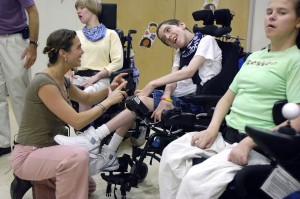Baclofen Therapy for Kids with Cerebral Palsy
Drug therapies for cerebral palsy are nothing new, however, some children are experiencing much-improved mobility after being implanted with a device that delivers medication right where it is needed; the baclofen pump.

ITB Therapy (Intrathecal Baclofen)
The Baclofen pump is a surgically implanted pump filled with a drug used to reduce muscle spasticity. It is implanted in the lower abdomen and delivers the drug directly to the spinal cord by catheter. Baclofen treatment is known to be extremely effective for some people. Risks include infection from surgery, seizures from overdoses, and depressed breathing. Statistics indicate the pump is safe and rarely results in any serious complications.
Baclofen has been used orally to reduce muscle spasms for a long time. Doctors discovered the benefits of the drug were increased when applied directly to the nerves causing cerebral palsy symptoms. The pump also produces fewer side effects than when Baclofen is taken orally. The benefits of reduced muscle tension increase the quality of life for many people with cerebral palsy.
Previous Methods of Treating Spasticity
In one particular case out of Indiana, a child was diagnosed with cerebral palsy when he was 15 months old. After having several surgeries, he was able to walk with the assistance of leg braces. Surgeries, however, did not help the muscle spasms that constitute among the most difficult symptoms of cerebral palsy.
Botox (usually associated with cosmetic surgery) is sometimes used to help treat muscle spasticity, but the child developed a tolerance to this particular drug, necessitating something new.
Advantages of Baclofen
Baclofen allows the muscles to relax, preventing the uneven tone and oftentimes extremely painful spasms that many cerebral palsy sufferers have to deal with on a constant basis.
The spasticity associated with cerebral palsy can make life extremely difficult for the people who suffer with it. Even cerebral palsy sufferers who are not completely disabled oftentimes endure periodic episodes of extremely painful spasms that leave them bedridden for days. Problems with muscle tone are also what make it difficult for people with CP to tackle tasks that require them to execute precise movements, such as writing, opening a door, using a can opener and so forth. With some drug therapies, these mobility problems may be diminished considerably.
Treatment But No Cure
Treatments for cerebral palsy are always improving, but as cerebral palsy is caused by irreversible damage to the developing brain, the condition never can be cured. The brain injury that causes the problems with muscle tone, speech, mobility and other issues is permanent, but the symptoms are increasingly being treated very effectively with innovative new methods.
